The Shoe Insoles Market is estimated to be valued at USD 6.4 billion in 2025 and is projected to reach USD 9.7 billion by 2035, registering a compound annual growth rate (CAGR) of 4.3% over the forecast period.
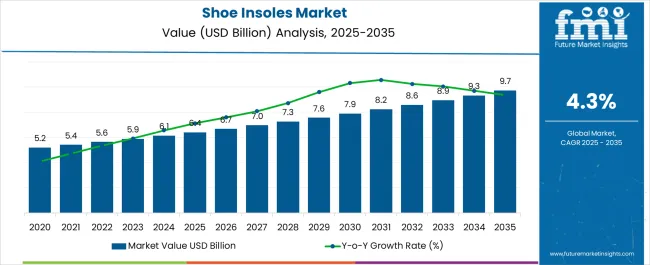
| Metric | Value |
|---|---|
| Shoe Insoles Market Estimated Value in (2025 E) | USD 6.4 billion |
| Shoe Insoles Market Forecast Value in (2035 F) | USD 9.7 billion |
| Forecast CAGR (2025 to 2035) | 4.3% |
The shoe insoles market is experiencing robust growth. Rising awareness about foot health, increasing participation in sports and fitness activities, and growing preference for comfortable footwear are driving demand. Current market dynamics are influenced by innovations in materials and ergonomic design that enhance cushioning, support, and durability.
Retail expansion and e-commerce penetration are improving product accessibility across regions. The future outlook is supported by rising disposable income, changing lifestyle trends, and increasing adoption of orthotic and specialty insoles to address foot disorders.
Growth rationale is based on the sustained need for comfort and performance in both everyday and professional footwear, continuous product development using advanced materials, and expansion of distribution networks that enhance availability in retail and online channels The market is expected to benefit from demographic shifts and the growing focus on preventive healthcare, ensuring steady adoption and incremental revenue growth across global consumer segments.
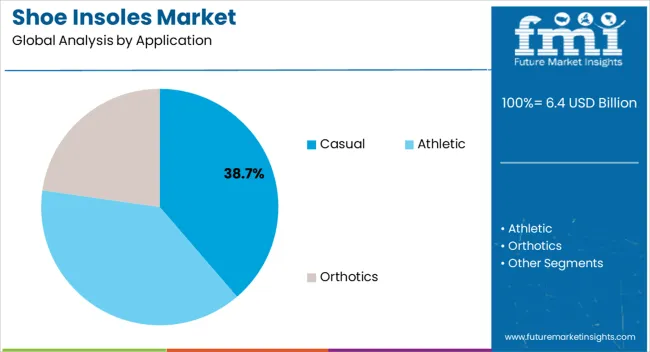
The casual segment, holding 38.70% of the application category, has maintained a leading position due to its widespread usage in daily footwear and lifestyle-oriented shoes. Demand has been driven by consumer preference for comfort during routine activities. Integration of ergonomic designs and adaptive cushioning technologies has enhanced product appeal.
Consistent adoption has been supported by retail availability and compatibility with a broad range of shoe types. Market share has been sustained through continuous product innovation and focus on durability and comfort.
Manufacturers have also capitalized on fashion and lifestyle trends to reinforce segment adoption Growth is expected to continue as casual footwear remains the most prevalent category in consumer footwear, ensuring sustained demand for associated insoles.
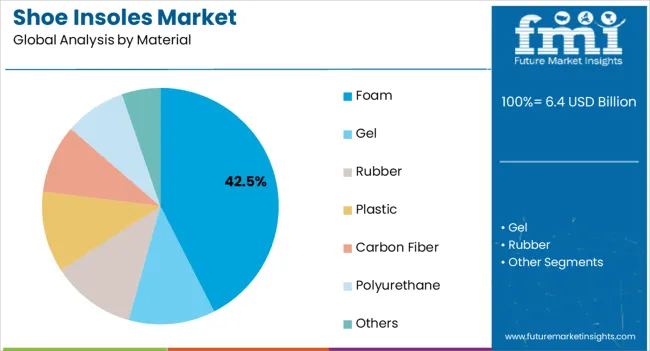
The foam segment, representing 42.50% of the material category, has been leading due to its lightweight, cushioning, and shock-absorbing properties. Its adoption has been supported by versatility in various insole designs and cost-effective manufacturing processes.
Foam insoles offer enhanced comfort and support, driving preference among consumers for daily use and sports activities. Manufacturing advancements in density control and resilience have improved product durability and performance.
Market acceptance has been reinforced by compatibility with casual, athletic, and specialty footwear Continued research in memory foam and other high-performance variants is expected to maintain the segment’s market share and drive growth.
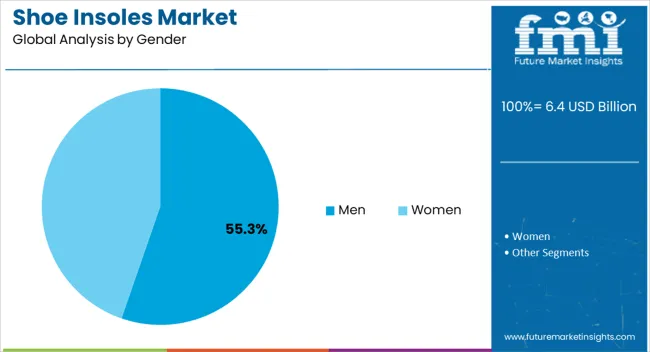
The men’s segment, accounting for 55.30% of the gender category, has remained dominant due to higher footwear consumption and focus on comfort and performance in male consumers. Adoption has been supported by demand in both casual and sports applications.
Market share has been reinforced by targeted product development, including ergonomic designs and high-cushioning solutions tailored to men’s footwear. Retail and online channels have improved accessibility and availability, sustaining segment growth.
Preference for durable and performance-oriented insoles, along with higher spending on footwear and accessories, is expected to support continued dominance of the men’s segment in the overall shoe insoles market.
There have been a lot of modifications and improvisations in the field of footwear, especially shoes. Trends and innovations driving the market are listed below.
The shoe insoles market across the world heavily relies on the overall trends in the footwear industry. The market is also influenced by increasing awareness of foot health, with consumers seeking insoles that offer comfort, support, and solutions for specific foot conditions.
Economic conditions, like disposable income, inflation, or supply chain stability, also have a significant impact on the global shoe insoles market. In the last few years, the market for shoe insoles has experienced a series of ups and downs.
In the pandemic, as the world faced sudden shutdowns, the shoe insoles market, in the initial phases, saw a plunge in demand as people refrained from spending on non-essential items. The market also suffered decreased distribution due to the disrupted supply chains. However, with time, as people got accustomed to the new normal, individuals focused on home workouts and outdoor activities. This drove the demand for athletic and performance-oriented insoles in the international marketplace.
Post-pandemic, as the markets opened again, the shoe insoles industry experienced a stabilized revenue growth. The emphasis on health and comfort by the general population all over the world is continuously influencing the demand for high-performance, comfort-giving insoles. In the future, innovations and technological advancements may play a significant role in the market, especially with the growing interest in smart and tech-infused footwear accessories.
| Attributes | Key Statistics |
|---|---|
| Historical Market Value (2020) | USD 4,970.2 million |
| Shoe Insoles Market Value (2025) | USD 5,836.8 million |
| HCAGR (2020 to 2025) | 4.10% |
The shoe insoles market is a USD 6 billion industry and is anticipated to grow at a CAGR of 4.50%. Despite the massive size, several factors are slowing down the growth rate for this market.
| Attributes | Details |
|---|---|
| Top Application | Orthotic |
| Market share in 2025 | 61.30% |
Over the years, shoe insoles have dominated the global orthotic industry, playing a pivotal role in providing personalized comfort, support, and therapeutic solutions for individuals with various foot conditions. They are in great demand in this industry due to the integration of advanced materials and technologies into insoles, which has transformed them from simple cushioning elements to sophisticated orthotic devices.
On the basis of application, the orthotic industry dominates the global shoe insoles market with a share of 61.30%. These insoles are designed to address a wide range of orthopedic issues, including arch support, plantar fasciitis, and pronation-related concerns. The market is also experiencing considerable growth as podiatrists often recommend orthotic insoles as part of treatment plans for various musculoskeletal conditions.
| Attributes | Details |
|---|---|
| Top Material | Foam-based |
| Market share | 32.50% |
Consumers all over the world, especially those seeking comfort in everyday shoes, have been actively looking for footwear solutions that not only offer a unique combination of comfort and support but also are adaptable to the user’s preferences and activities. Foam-based insoles, such as memory foam, provide a customized and cushioned feel, ensuring optimal support for various foot arch types.
On the basis of material, foam-based shoe insoles dominate the global market with a share of 32.50%. Foam-based insoles are in great demand not just among the day-to-day users but also athletes seeking enhanced performance. These insoles excel in distributing pressure evenly across the foot, reducing impact during daily activities and providing a soft yet supportive foundation.
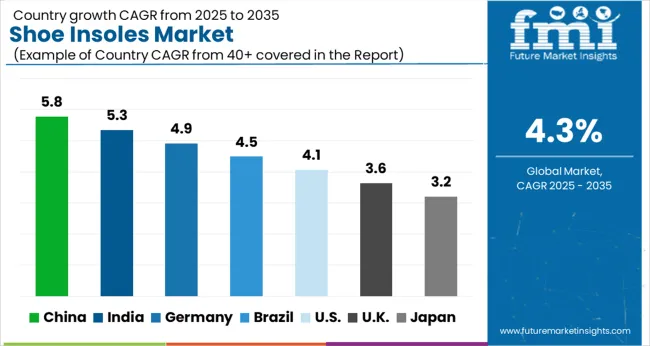
The Indian shoe insoles market is anticipated to retain its dominance by progressing at a CAGR of 6.50% till 2035.
India is blessed with a significant portion of its population in its youth stage. Increasing disposable incomes, in this demographic, are driving the demand for better quality footwear and accessories, including insoles. The country has also been going through a phase of transition, where the general population is increasingly adopting Western lifestyles, further fueling the growth of the insole market.
China is another Asian country that is driving market growth. Over the next ten years, the demand for shoe insoles in China is projected to rise at a 6.10% CAGR.
China is home to one of the largest populations in the world. The country’s rapid urbanization has led to lifestyle changes, including increased awareness of health and wellness. Sedentary habits, due to corporatization of jobs, are driving the demand for insoles to enhance foot comfort and address various health issues. The influx of international brands in the country is also one of the main contributors to this exponential growth.
The market in Australia for shoe insoles is poised to showcase a CAGR of 4.00% from 2025 to 2035.
Australia is known for its outdoor culture. Activities like hiking, running, and sports, have driven the demand for specialized insoles that cater to the needs of outdoor enthusiasts. Besides this, the awareness of the impact of footwear on overall health has led to an increased demand for insoles, especially among individuals looking for solutions to common foot problems related to physical activity.
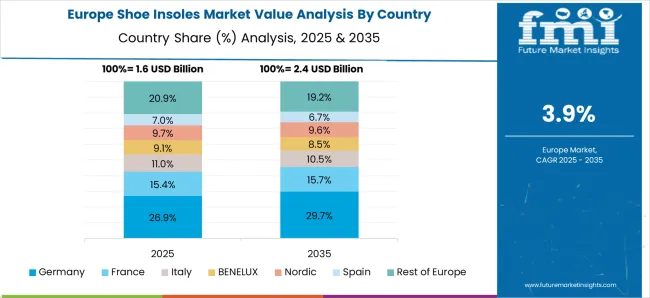
In the European region, Germany is leading the shoe insoles market. The German market is anticipated to register a CAGR of 3.80% through 2035.
The growth in the market in Germany is attributed to consumers seeking high-quality, technologically advanced insoles that provide superior comfort and support. Apart from this, Germany is also home to one of the largest geriatric populations in the world. As individuals age, they become more susceptible to foot-related issues, leading to an increased demand for therapeutic shoe insoles.
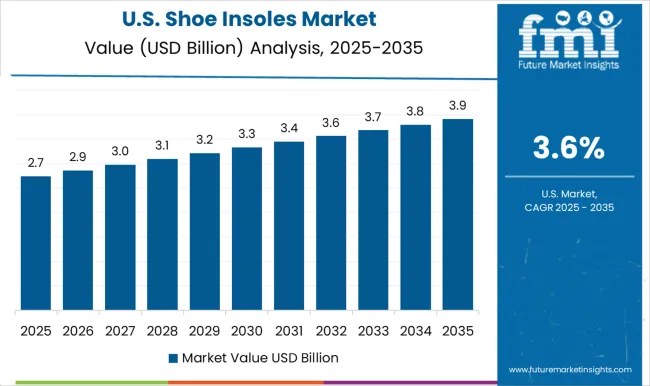
In the North American region, the United States shoe insoles market is anticipated to register a CAGR of 2.50% through 2035.
The rising cases of fatal cardiovascular diseases like hypertension, obesity, and diabetes in the United States has pushed the general population to adopt to an active lifestyle, which includes regular exercises, especially running. As more Americans engage in physical activities, there is a growing demand for insoles that provide comfort and support during exercise, contributing to the overall market growth.
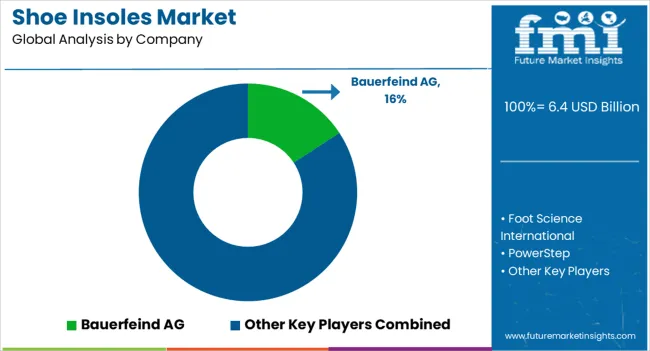
The market for shoe insoles is heavily dominated by a few international brands, such as FootBalance System, PowerStep, Foot Science International, Bauerfeind AG, etc., who have their reach spread across all the major countries in the world. These companies, over a period of time, have built a substantial consumer base.
There is a presence of small companies in the market, too. These companies cater to the demands of regional consumers. Small companies have to face challenges, like lower profit margins, limited financial resources for research and development, and restricted marketing capabilities.
Recent Developments
The global shoe insoles market is estimated to be valued at USD 6.4 billion in 2025.
The market size for the shoe insoles market is projected to reach USD 9.7 billion by 2035.
The shoe insoles market is expected to grow at a 4.3% CAGR between 2025 and 2035.
The key product types in shoe insoles market are casual, athletic and orthotics.
In terms of material, foam segment to command 42.5% share in the shoe insoles market in 2025.






Full Research Suite comprises of:
Market outlook & trends analysis
Interviews & case studies
Strategic recommendations
Vendor profiles & capabilities analysis
5-year forecasts
8 regions and 60+ country-level data splits
Market segment data splits
12 months of continuous data updates
DELIVERED AS:
PDF EXCEL ONLINE
Shoe Bite Tape Market Size and Share Forecast Outlook 2025 to 2035
Competitive Overview of Shoe Packaging Companies
Shoe Insert Market Outlook – Demand, Trends & Forecast 2024-2034
Shoe Packaging Market by Packaging Format & Sustainability from 2024 to 2034
Shoe Storage & Organizers Market
Shoe Dryers Market
UK Shoe Insert Market Insights – Growth, Share & Industry Trends 2025-2035
Gym Shoes Market Size and Share Forecast Outlook 2025 to 2035
GCC Shoe Insert Market Report – Size, Share & Growth 2025-2035
USA Shoe Insert Market Outlook – Demand, Growth & Industry Forecast 2025-2035
Baby Shoes Market Size and Share Forecast Outlook 2025 to 2035
Work Shoes Market Trends - Demand & Forecast 2025 to 2035
Golf Shoes Market Analysis – Growth, Demand & Forecast 2024-2034
Water Shoes Market Trends – Demand & Forecast 2025 to 2035
Smart Shoes Market - Trends, Growth & Forecast 2025 to 2035
Japan Shoe Insert Market Trends – Size, Demand & Forecast 2025-2035
Trail Shoes Market
Brake Shoe Market
Tennis Shoes Market Insights - Demand & Growth 2025 to 2035
Casual Shoes Market Size and Share Forecast Outlook 2025 to 2035

Thank you!
You will receive an email from our Business Development Manager. Please be sure to check your SPAM/JUNK folder too.
Chat With
MaRIA